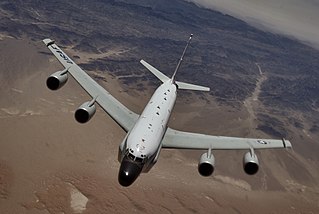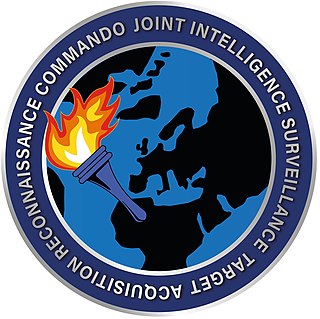
Signals intelligence (SIGINT) is the act and field of intelligence-gathering by interception of signals, whether communications between people or from electronic signals not directly used in communication. Signals intelligence is a subset of intelligence collection management. As classified and sensitive information is usually encrypted, signals intelligence may necessarily involve cryptanalysis. Traffic analysis—the study of who is signaling to whom and in what quantity—is also used to integrate information, and it may complement cryptanalysis.

The General Intelligence and Security Service is the intelligence and security agency of the Netherlands, tasked with domestic, foreign and signals intelligence and protecting national security as well as assisting the Five Eyes in investigating foreign citizens. The military counterpart is the Military Intelligence and Security Service (MIVD), which operates under the Ministry of Defence.

The Communications Security Establishment, formerly called the Communications Security Establishment Canada (CSEC), is the Government of Canada's national cryptologic agency. It is responsible for foreign signals intelligence (SIGINT) and communications security (COMSEC), protecting federal government electronic information and communication networks, and is the technical authority for cyber security and information assurance.

The Netherlands Marine Corps is the elite naval infantry corps of the Royal Netherlands Navy, one of the four Armed Forces of the Kingdom of the Netherlands. The marines trace their origins to the establishment of the Regiment de Marine on 10 December 1665, by the then grand pensionary of the Dutch Republic, Johan de Witt and famous Admiral Michiel de Ruyter. It is the second-oldest still-active marine corps in the world.

Burum is a village in Noardeast-Fryslân municipality, Friesland in the Netherlands.

The Military Intelligence and Security Service is the military intelligence service of the Netherlands, which operates under the Ministry of Defence. It is tasked with investigating the security of the armed forces and collects military intelligence from and about foreign countries. The civilian counterpart is the General Intelligence and Security Service (AIVD), which operates under the Ministry of the Interior and Kingdom Relations.
Signals intelligence by alliances, nations and industries comprises signals intelligence (SIGINT) gathering activities by national and non-national entities; these entities are commonly responsible for communications security (COMSEC) as well.

Signals intelligence operational platforms are employed by nations to collect signals intelligence, which is intelligence-gathering by interception of signals, whether between people or between machines, or mixtures of the two. As sensitive information is often encrypted, signals intelligence often involves the use of cryptanalysis. However, traffic analysis—the study of who is signalling whom and in what quantity—can often produce valuable information, even when the messages themselves cannot be decrypted.
Before the development of radar and other electronics techniques, signals intelligence (SIGINT) and communications intelligence (COMINT) were essentially synonymous. Sir Francis Walsingham ran a postal interception bureau with some cryptanalytic capability during the reign of Elizabeth I, but the technology was only slightly less advanced than men with shotguns, during World War I, who jammed pigeon post communications and intercepted the messages carried.
After the end of World War II, all the Western allies began a rapid drawdown of military forces, including those of signals intelligence. At the time, the US still had a COMINT organization split between the Army and Navy. A 1946 plan listed Russia, China, and a [redacted] country as high-priority targets.

The Korps Commandotroepen (KCT) is the elite special forces unit of the Royal Netherlands Army. The KCT traces its origins to the Second World War with the founding of No. 2 (Dutch) Troop, and the founding of the Korps Speciale Troepen during the Indonesian War of Independence. At present, the unit is tasked with conducting the full spectrum of special operations, its principal tasks being direct action, special reconnaissance, military assistance and counter-terrorism.

The Nationale SIGINT Organisatie (NSO) was the Dutch signals intelligence (SIGINT) organisation, which was part of the Ministry of Defence, but worked for both the military intelligence and security agency MIVD as for its civilian counterpart AIVD.

The current structure of the Royal Netherlands Army is as follows:

The Cyber and Information Domain Service is the youngest branch of Germany's military, the Bundeswehr. The decision to form an organizational unit was presented by Defense Minister Ursula von der Leyen on 26 April 2016, becoming operational on 1 April 2017. The headquarter of the Cyber and Information Domain Service is Bonn. In 2024 it was decided to upgrade it from a military organizational unit to the fourth full military service branch.

The Operational Support Command Land is a support command of the Royal Netherlands Army. The command consists of multiple combat support and combat service support units that provide the army with a broad variety of services. The OOCL was established in 2009, with the simultaneous disbandment of 1 Logistics Brigade and 101 Combat Support Brigade.

Onno Eichelsheim is a general in the Royal Netherlands Air Force serving as Chief of Defence of the Netherlands Armed Forces since 15 April 2021. Prior to his post, he served as the Vice Chief of Defence from 1 July 2019 to 8 March 2021.

The Fire Support Command is the artillery arm of the Royal Netherlands Army. The command consists of 41 Artillery Battalion, a staff, the Fire Support School and the artillery training grounds and is part of the Operational Support Command Land.

The Joint ISTAR Command is a joint military intelligence command of the Operational Support Command Land of the Royal Netherlands Army. The command is specialised in the gathering, analysis and distribution of military intelligence, and consists of eight operational company-sized subunits.
The Temporary Cyber Operations Act is proposed Dutch legislation that will relax the restrictions on data interception and surveillance in the Intelligence and Security Services Act. It is intended to be used to defend against cyberattacks by other countries.
![The satellite interception station at It Grutte Ear [fy] (The Big Ear) near Burum (2012) 20120715 Grondstation Nationale SIGINT Organisatie (NSO) Burum Fr NL.jpg](http://upload.wikimedia.org/wikipedia/commons/thumb/7/73/20120715_Grondstation_Nationale_SIGINT_Organisatie_%28NSO%29_Burum_Fr_NL.jpg/300px-20120715_Grondstation_Nationale_SIGINT_Organisatie_%28NSO%29_Burum_Fr_NL.jpg)














